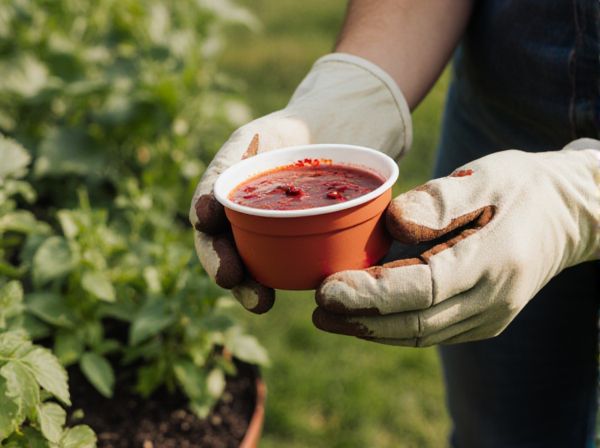
Blood meal vs Bone meal Illustration
Blood meal and bone meal are both organic fertilizers rich in essential nutrients but serve different purposes for plant growth. Blood meal is high in nitrogen, promoting vigorous leaf and stem development, while bone meal provides phosphorus, supporting strong root growth and flowering. Choosing the right fertilizer depends on the specific nutrient needs of the plants in your garden.
Table of Comparison
| Feature | Blood Meal | Bone Meal |
|---|---|---|
| Primary Nutrient | Nitrogen (N) | Phosphorus (P) |
| Nutrient Content | 12-0-0 (N-P-K) | 3-15-0 (N-P-K) |
| Use | Boosts leafy growth | Enhances root development and flowering |
| Release Rate | Fast-release | Slow-release |
| pH Range | Best in acidic to neutral soils | Suitable for neutral to alkaline soils |
| Application Method | Broadcast or side dressing | Incorporate into soil before planting |
| Best Crops | Leafy vegetables, corn | Root crops, flowering plants |
| Organic Certification | Yes | Yes |
| Source | Animal blood | Animal bones |
| Odor | Strong, distinct smell | Mild odor |
Understanding Blood Meal and Bone Meal
Blood meal is a high-nitrogen organic fertilizer derived from dried animal blood, providing a rapid nitrogen boost essential for leafy plant growth and soil microbial activity. Bone meal, made from finely ground animal bones, is a rich source of phosphorus and calcium, promoting strong root development and flowering. Both fertilizers improve soil fertility but serve different nutrient requirements, with blood meal focusing on nitrogen and bone meal supplying phosphorus and calcium.
Key Nutrients in Blood Meal vs Bone Meal
Blood meal is a rich source of nitrogen, typically containing about 12-14% nitrogen, which promotes vigorous leaf and stem growth in plants. Bone meal provides a high concentration of phosphorus, usually around 15-20%, essential for strong root development and flowering. Both fertilizers supply calcium, but blood meal's rapid nitrogen release contrasts with bone meal's slow phosphorus availability, targeting different nutrient needs in soil management.
Benefits of Using Blood Meal in the Garden
Blood meal is an excellent organic fertilizer rich in nitrogen, promoting vigorous leafy growth and enhancing overall plant health. It quickly improves soil fertility by supplying essential nutrients that stimulate microbial activity and root development. Using blood meal helps boost plant resistance to pests and diseases while increasing crop yields in vegetable gardens and lawns.
Advantages of Bone Meal for Plant Growth
Bone meal is a rich source of phosphorus and calcium, essential nutrients that promote healthy root development and improve flowering and fruiting in plants. Its slow-release nature ensures a steady supply of nutrients over time, reducing the risk of nutrient burn compared to blood meal. Incorporating bone meal into soil enhances soil structure and microbial activity, contributing to long-term plant growth and soil fertility.
Ideal Plants for Blood Meal Application
Blood meal is an excellent nitrogen-rich fertilizer ideal for leafy greens, such as spinach, lettuce, and kale, which require rapid foliage growth. It is also beneficial for corn, tomatoes, and other fruiting plants that need a nitrogen boost during early development stages. Using blood meal promotes vigorous green growth and improved plant health, making it perfect for heavy feeders demanding high nitrogen levels.
Best Plants for Bone Meal Enrichment
Bone meal is a rich source of phosphorus and calcium, making it ideal for flowering plants, root vegetables, and fruiting crops such as tomatoes, carrots, and peppers. Its slow-release properties support strong root development and enhanced bloom production, benefiting plants like dahlias, roses, and bulbs. Unlike blood meal, which is high in nitrogen for leafy growth, bone meal specifically enriches plants requiring robust root systems and abundant flowering.
How to Apply Blood Meal Safely
Apply blood meal by lightly sprinkling it around the base of plants to avoid direct contact with foliage, which can cause burning. Water the soil immediately after application to help the nitrogen-rich blood meal absorb into the ground and prevent nutrient runoff. Use gloves and avoid inhaling the dust to ensure safe and effective handling while fertilizing.
Proper Bone Meal Application Practices
Proper bone meal application requires incorporating it into the soil before planting to maximize nutrient availability and avoid nitrogen immobilization. Optimal bone meal use involves applying 10 to 20 pounds per 100 square feet, depending on soil test results to address phosphorus deficiencies effectively. Maintaining soil pH between 6.0 and 7.0 enhances bone meal's phosphorus release, promoting healthy root development and improved plant growth.
Environmental Impact: Blood Meal vs Bone Meal
Blood meal, derived from animal blood, has a lower environmental footprint due to its rapid nitrogen release, reducing the risk of nutrient runoff and water pollution. Bone meal, sourced from crushed animal bones, releases phosphorus more slowly, which can lead to longer-term soil enrichment but may contribute to phosphorus runoff if overapplied. Choosing blood meal or bone meal depends on balancing immediate nutrient needs with potential impacts on water quality and soil health.
Choosing the Right Fertilizer for Your Garden
Blood meal offers a high nitrogen content, ideal for leafy green growth, while bone meal provides essential phosphorus for strong root development and flowering. Selecting the right fertilizer depends on your garden's specific nutrient needs and the types of plants you are growing. Incorporate blood meal for quick nitrogen boosts and bone meal for long-term phosphorus enrichment to optimize plant health and yield.
Blood meal vs Bone meal Infographic

 gardendif.com
gardendif.com